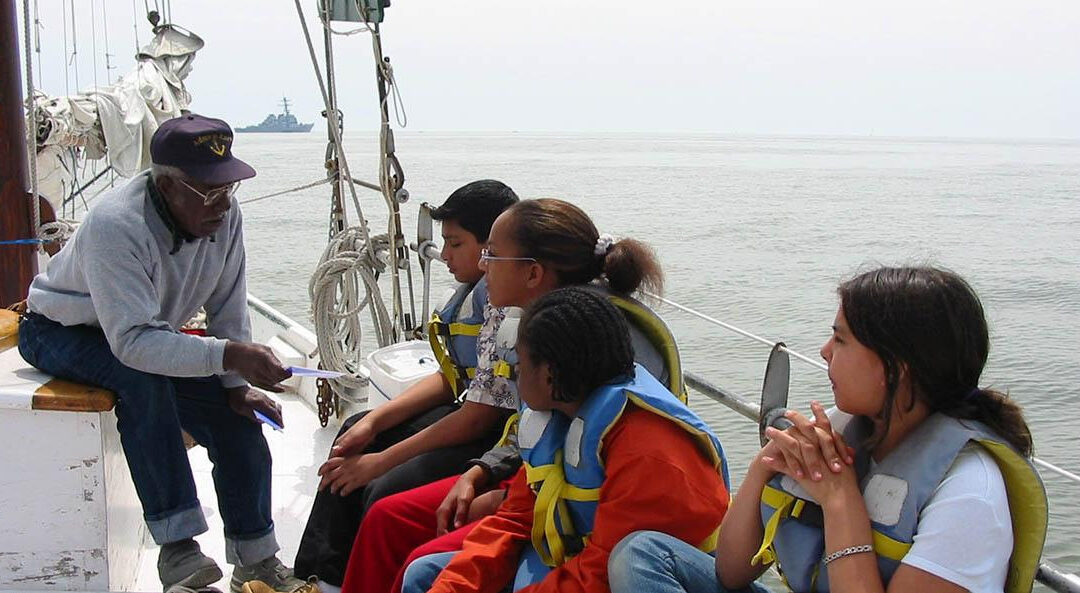Earl White, educator and third-generation waterman, shares his knowledge and love for the Bay with students on a Chesapeake Bay Foundation field experience
(Photo Credit: CBF Photo)
Mapping and Sharing Stories of Black History in the Chesapeake Watershed
By Kendra Parzen, a Field Officer with the National Trust for Historic Preservation
As home to some of America’s first colonies, the Chesapeake Bay watershed region has significant meaning to centuries of African American history. Many major tobacco plantations were located here, as were numerous stops on the Underground Railroad. The region includes many battlegrounds of the Civil War, as well as places of notable activism in the 1960s Civil Rights Movement. Generations of Black Americans have made their living from the waters of the Bay as boat captains, oyster tongers, crab pickers and more. Special places along the Bay and throughout the region also provided treasured places for outdoor recreation. But many of the places that hold the stories of African American life in the watershed are still under-recognized and unprotected.
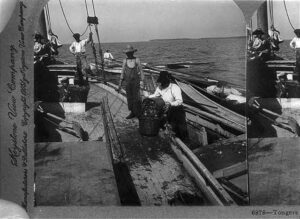 To begin addressing this deficit, a group of partners including the National Trust for Historic Preservation; the National Park Service Chesapeake Office; the states of Maryland, Pennsylvania, and Virginia; and the Chesapeake Conservation Partnership are undertaking a long-term initiative, entitled “Documenting Chesapeake Watershed Sites and Landscapes Important to African Americans,” or the Chesapeake Mapping Initiative. The National Trust’s involvement is supported by the African American Cultural Heritage Action Fund. The Chesapeake Mapping Initiative is intended to ensure that places important to African Americans are better represented in historic preservation and land conservation priorities in the Chesapeake Bay region by increasing the number of Black history sites included in state-level Cultural Resource Information Systems and the Chesapeake Conservation Partnership’s Chesapeake Conservation Atlas, where this data can inform land use and planning decisions.
To begin addressing this deficit, a group of partners including the National Trust for Historic Preservation; the National Park Service Chesapeake Office; the states of Maryland, Pennsylvania, and Virginia; and the Chesapeake Conservation Partnership are undertaking a long-term initiative, entitled “Documenting Chesapeake Watershed Sites and Landscapes Important to African Americans,” or the Chesapeake Mapping Initiative. The National Trust’s involvement is supported by the African American Cultural Heritage Action Fund. The Chesapeake Mapping Initiative is intended to ensure that places important to African Americans are better represented in historic preservation and land conservation priorities in the Chesapeake Bay region by increasing the number of Black history sites included in state-level Cultural Resource Information Systems and the Chesapeake Conservation Partnership’s Chesapeake Conservation Atlas, where this data can inform land use and planning decisions.
Work on the Chesapeake Mapping Initiative has been ongoing since 2020. Project partners are currently undertaking unique pilot projects in Maryland, Virginia, and Pennsylvania to identify sites and landscapes significant to African American history and to gather baseline GIS data on these historic places.
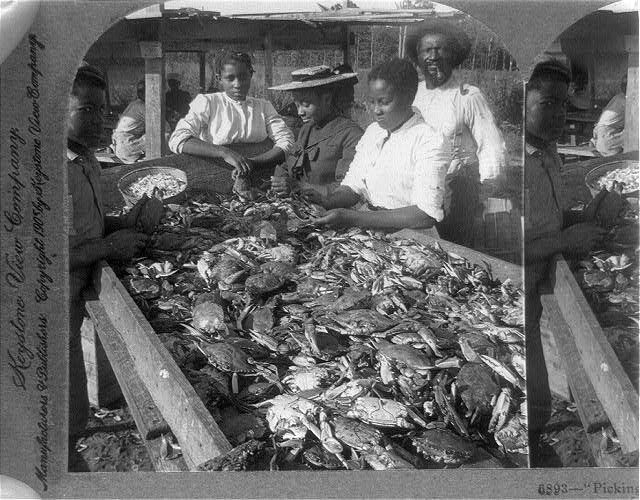
Picking crabs for market on banks of the Chesapeake Bay, MD (Photo Credit: Library of Congress Prints and Photographs Division Washington, D.C.)
Virginia
In Virginia, work focuses on the identification of historic resources associated with Black watermen culture in Virginia’s coastal communities. Survey work is informing the creation of approximately 80 new records in V-CRIS, Virginia’s state cultural resource information system. Another product of this work will be a Multiple Property Document (MPD), which will streamline the nomination of Black watermen-related individual sites or historic districts to the National Register of Historic Places, as well as a flagship National Register nomination under that MPD. More information and updates on this project are available through the website of the Virginia Department of Historic Resources.
Maryland
In Maryland, local historians are analyzing the existing records of the Maryland Historical Trust in the state’s Medusa system for areas where African American historical connections are missing. Looking at all existing records in the watershed counties of Kent, Calvert, and Somerset, they are using their knowledge of area history to identify places where African American history has been left out and recommending where surveying and research can help correct those omissions and reflect a more complete history of these places.
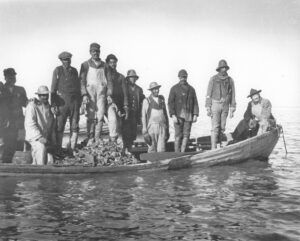 Pennsylvania
Pennsylvania
The Pennsylvania State Historic Preservation Office’s Baseline Survey Effort 2020-2024 kicked off in 2020 with a particular focus on identifying African American churches and cemeteries. A complimentary crowdsourcing effort that began in 2022 asks communities in south-central Pennsylvania to share their knowledge of places that are connected to African American history in select counties, including Adams, Cumberland, Dauphin, Franklin, Fulton, Lancaster, Lebanon, Perry, and York. Once collected, the project team will research and add additional information where needed with a goal of creating a minimum of 45 new records in Pennsylvania’s PA-SHARE system.
Collectively, these projects are only a small step towards documenting the breadth of Black history in the Chesapeake Watershed, but they will also lay the groundwork for future mapping efforts for African American historic places by demonstrating the effectiveness of different project approaches. Once the pilot projects are complete, the National Trust will analyze the results and draw lessons for future phases of this work. Ultimately, this effort will result in a more equitable understanding of the watershed’s history that can be used to educate the public. A second phase, focused on expanding crowdsourcing as a tool for this work, is anticipated to kickoff later in 2022.
*The National Trust for Historic Preservation, a privately funded nonprofit organization, works to save America’s historic places. Funding for the Chesapeake Mapping Initiative has been provided in part by the National Park Service Chesapeake Bay Gateways Program and by the Environmental Stewardship Fund of the Pennsylvania Department of Conservation and Natural Resources. Additional support is provided by State Funds from the Maryland Heritage Areas Authority, an instrumentality of the State of Maryland. However, the contents and opinions do not necessarily reflect the views or policies of the Maryland Heritage Areas Authority.
The Descendant Families of Arlington House
Provided by the National Park Service, George Washington Memorial Parkway
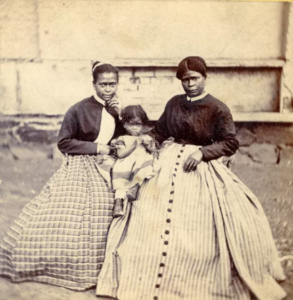 Arlington House in Northern Virginia is the nation’s memorial to Robert E. Lee – in a larger sense it exists as a place of study and contemplation of the meaning of some for the most difficult aspects of American history: military service, sacrifice, slavery and freedom.
Arlington House in Northern Virginia is the nation’s memorial to Robert E. Lee – in a larger sense it exists as a place of study and contemplation of the meaning of some for the most difficult aspects of American history: military service, sacrifice, slavery and freedom.
Over the 60 years leading up to the Civil War, Arlington House was home to at least 100 enslaved African Americans who lived and labored on the estate. Enslaved people at Arlington House lived difficult lives of forced labor. However, they found small ways to resist, in addition to building families and close connections with each other. The National Park Service interprets the history of the Lee and Custis families and the stories of those enslaved by them, including the Syphax, Burke, Parks and Gray families to present a more complete story of life at Arlington House.
Freedom for people enslaved at Arlington House ultimately came with the Civil War. As Union armies overran the estates, some took advantage of the opportunity to flee north, while others stayed on the plantation. At the end of 1862, following the wishes of his father-in-law, Lee ordered the freedom of the 63 people owned by the Custis family at Arlington.
In the years that followed, these families built new homes and lives not far from where they had once been enslaved. With the creation of Freedman’s Village by the Federal Government in 1863, thousands of African Americans who had emancipated themselves from slavery established a community on what once was the Arlington plantation. At Arlington they formed deep bonds with each other, and many of these bonds continue among their descendants today.
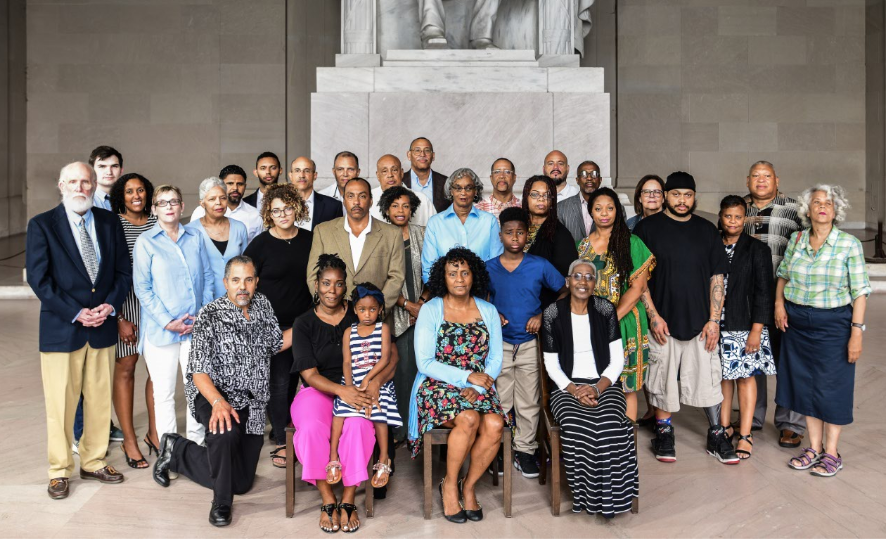
Descendant Families of Arlington House (Photo Credit: NPS Image)
While the story of those enslaved at the Arlington House plantation has been left out of many popular narratives, the National Park Service is dedicated to telling their story. Visitors to Arlington House can learn about enslaved people who worked at the estate, such as the Syphax, Burke, Parks and Gray families, including learning stories about their daily life on the plantation and their families’ legacies. The newly restored outbuildings that served as living and working quarters for enslaved people are open to the public.
A major rehabilitation effort completed in the summer of 2021 included artifact conservation, facilities restoration, and the installation of new interpretive exhibits that include multiple historical perspectives and are grounded in current research. New archeological findings have shed light on past behaviors of enslaved individuals. Today, the National Park Service tells the whole story of slavery at Arlington House, recognizing that speaking openly about this history might engender discomfort in ourselves, our colleagues and our visitors, because it helps us to understand the complete story of our collective history and acknowledge those who have been too long ignored by the dominant narrative. The National Park Service acknowledges and recognizes the lives of those enslaved at Arlington House with respect, humanity, empathy and agency. Visit the National Park Service website to stay updated on future collaboration efforts between the Park and the Descendant Families of Arlington House.
Tracing Lives in Slavery, Reclaiming Lives in Freedom: Hampton National Historic Site Ethnographic Overview and Assessment
Provided by the National Park Service, Hampton National Historic Site
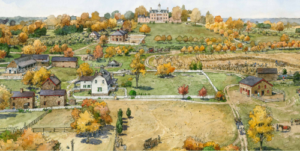 Once possibly the largest private home in America by 1790, the Hampton mansion in Baltimore County, Maryland serves as a story of its people, as the estate evolved through the actions of the Ridgely family, enslaved African Americans, European indentured servants and paid laborers within a nation struggling to define its own concept of freedom.
Once possibly the largest private home in America by 1790, the Hampton mansion in Baltimore County, Maryland serves as a story of its people, as the estate evolved through the actions of the Ridgely family, enslaved African Americans, European indentured servants and paid laborers within a nation struggling to define its own concept of freedom.
Hampton National Historic Site sits on rich soil that was once at the core of Maryland’s second-largest plantation and an ironworks complex. The period of slavery at Hampton, which spanned more than a century, encompassed the American Revolution and the Civil War, only ending when Maryland State law ended the institution in 1864. Farming and ironworking bound together slaveowners, enslaved persons, indentured servants, convict laborers, immigrant laborers, paid artisans and free black laborers. Together, these people shared a common history, connected through moments of collaboration and conflict.
From the colonial period through 1864, the Ridgelys enslaved over 500 people. African American enslaved persons, from young children to the elderly, labored at Hampton plantation and the Northampton furnace, as ironworkers, founders, limestone and marble quarriers, millers, blacksmiths, gardeners, dairymaids, jockeys, cobblers, seamstresses, woodcutters, field hands, carriage drivers, cooks, childcare providers, cleaners, builders and even overseers in the early days of the ironworks. All these positions combined to create a community within the plantation in which enslaved people held meetings, lived together and practiced their religion while simultaneously being subject to forms of control from slaveholders and overseers.
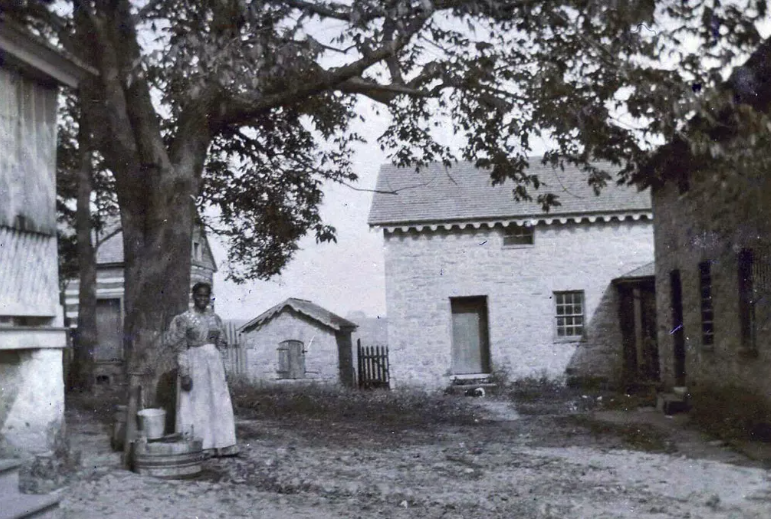
Image of a tenant farmer woman, possibly Amanda Norris, outside the former Slave Quarters 1897 (Photo Credit: Library of Congress Prints and Photographs Division Washington, D.C.)
Although we know little about enslaved individuals from their own words, it is possible to recover some of their stories from the vast number of historic documents related to the Hampton estate. For more than 50 years, however, the lives, families and labors of those who were enslaved there remained under-researched. Following important initial investigations in the 1990s, the 2014 Historic Resource Study expanded the National Park Service’s understanding of the lived experiences of indentured servants and enslaved persons.
Most recently, a four-year Ethnographic Overview and Assessment for Hampton National Historic Sites from 2016-19 focused on establishing the connections of enslaved families in Hampton’s enslaved community: finding where the formerly enslaved lived in freedom and if they had living descendants. In 2020 the report was published. The study not only focused on the people emancipated from Hampton, but it also identified hundreds of their family members and descendants, following them down through the generations to people living today in communities across multiple states. The study uncovered details of the personal lives of these individuals, their intertwining family connections, and the neighborhoods in which they lived post-Emancipation.
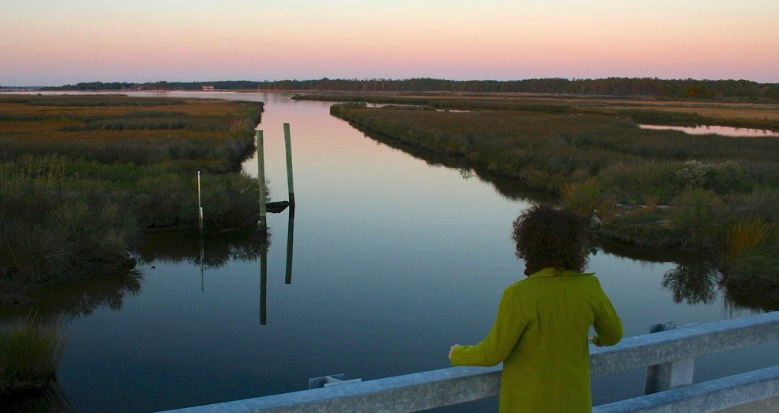
Stewart’s Canal on the historic eastern Maryland landscape where Harriet Tubman emancipated herself and members of her family
(Photo Credit: NPS Image)
Beyond beautiful places, the National Park Service and the work of several organizations and agencies protect our nation’s historic sites and stories. As we celebrate Juneteenth and continue to have difficult conversations around race and reconciliation as a nation, we, as a community, must remain committed to protecting tangible and intangible resources that demonstrate how diverse and complex our nation’s history really is, ensuring that they’re preserved for the betterment of future generations.
Image credit:
- Tongers selling oysters to market boats, Chesapeake Bay, MD (Photo Credit: Library of Congress Prints and Photographs Division Washington, D.C.)
- Watermen culling oysters (Photo Credit: The Mariners’ Museum and Park)
- Selina Gray and her daughters (Photo Credit: NPS Image)
- A depiction of what Hampton Estate would have looked like in its height as a plantation (Photo Credit: NPS Image/ Artwork by Richard Schlecht)
Lightning Update is a regular communication of the Chesapeake Conservation Partnership. Any opinions expressed are those of the authors and do not necessarily reflect positions of the Partnership or member organizations.
To share a success story, news, or important event, send your information to:
Support for the Chesapeake Conservation Partnership is provided by:
National Park Service Chesapeake
EPA Chesapeake Bay Program
USDA Forest Service
Pennsylvania Department of Conservation & Natural Resources
Maryland Department of Natural Resources
Virginia Outdoors Foundation
US Fish & Wildlife Service
Chesapeake Conservancy
The Chesapeake Conservation Partnership is co-convened by:




